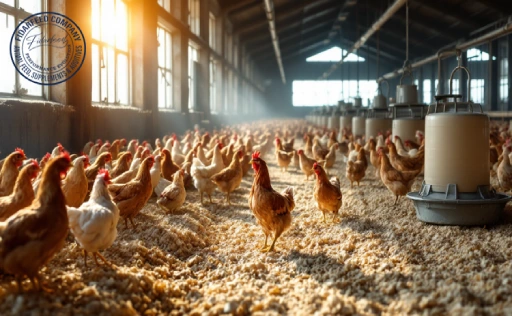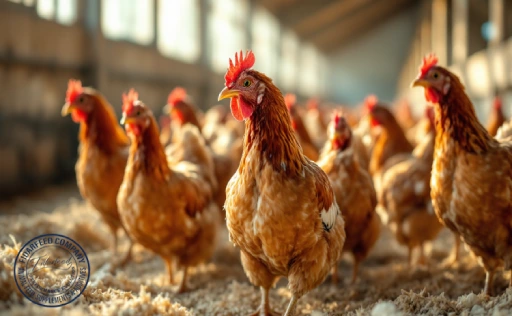
The Chicken Egg Production Cycle is at the heart of every successful layer operation. Whether you’re managing a commercial poultry business or raising hens in your backyard, understanding how eggs are formed and what influences production can significantly improve your results. From selecting the right breeds to managing nutrition, environment, and health, every step matters. This guide will walk you through each stage of the egg-laying cycle with practical insights and expert-backed advice to help you maximize both quantity and quality.
Why Understanding the Egg-Laying Process Matters
The egg production cycle is the natural process hens go through to produce eggs. It starts before the hen lays her first egg and includes several key stages: growth, sexual maturity, peak laying, decline, and molting. For breeders, understanding this cycle is essential.
Learn more about: Active Probiotic Yeast for Poultry
It allows for better planning, increased productivity, and improved animal welfare. A well-informed breeder can reduce downtime, manage costs more effectively, and maintain a healthier flock.
How Breed Selection Affects Egg Quantity and Quality
Not all chickens are created equal when it comes to egg laying. Breeds like the White Leghorn are famous for their high egg output, while others like the Rhode Island Red balance good production with hardiness.
Learn more about: How to Treat Arthritis in Chickens: Key Strategies for Healthier Breeder Birds
Choosing the right breed affects how many eggs your hens lay, how long they stay productive, and how they respond to feeding and housing conditions. Tailoring your breed selection to your farm’s goals and local environment is a foundational step in the production cycle.

Preparing the Ideal Environment to Support the Chicken Egg Production Cycle
Environment has a direct impact on the productivity and well-being of laying hens. Clean, spacious housing with proper ventilation reduces stress and disease risk. Nesting boxes should be dark, quiet, and comfortable to encourage consistent laying.
Learn more about: Decreased Egg Production in Laying Hens: Common Diseases in Chickens to Watch
Lighting also plays a pivotal role—hens need 14-16 hours of light per day to maintain peak production. Investing in an automated lighting system can help simulate optimal day lengths year-round.
Nutrition Essentials: Feeding for Every Stage of the Chicken Egg Production Cycle
Feeding strategies must align with the bird’s stage in the egg production cycle. Pullets require high-protein starter feed to build strong muscles and bones.
Learn more about: Cobb 500: The Broiler Breeder’s First Choice – Unveiled
As they approach laying age, switch to a developer feed, then to a layer feed enriched with calcium, phosphorus, and vitamin D3. These nutrients are critical for strong shells and consistent egg laying. Access to clean water and occasional grit for digestion are equally vital.

From Pullet to Layer: The Key Phases in the Chicken Egg Production Cycle
A pullet becomes a layer around 18-20 weeks of age. The first eggs are usually small, but size and frequency increase as the bird matures.
Learn more about: Boost Poultry Health: How Zeolite Cuts Ammonia and Cleans the Air
Hens typically reach peak production at around 30 weeks and maintain it for several months before gradually declining. Recognizing each phase helps you provide age-appropriate care and anticipate changes in production.
Hormones and Physiology Behind the Chicken Egg Production Cycle
Egg production is governed by a hen’s endocrine system. Hormones like estrogen and luteinizing hormone (LH) play a critical role in ovulation and shell formation.
Learn more about: Boost Your Egg Production with Classica Layer Chickens
A mature ovum travels from the ovary through the oviduct, where it receives the yolk, white, membranes, and shell. Disruptions in hormone levels—caused by stress, illness, or poor nutrition—can halt or alter this delicate process.

Biosecurity and Disease Prevention Throughout the Chicken Egg Production Cycle
Maintaining flock health is key to sustained egg production. Implement strict biosecurity protocols: limit farm visitors, sanitize equipment regularly, and quarantine new birds.
Learn more about: Boosting Broiler Breeder Egg Production: A Comprehensive Lighting Guide
Vaccinations should be part of your health program, covering diseases like Marek’s, Newcastle, and Infectious Bronchitis. Early detection of illness—signaled by changes in appetite, egg quality, or behavior—can save your flock.
Managing Molting and Its Impact on the Chicken Egg Production Cycle
Molting is a natural phase when hens shed old feathers and pause egg production to conserve energy.
Learn more about: Boosting Broiler Breeder Egg Production: A Comprehensive Lighting Guide
It usually occurs annually and can last 6-12 weeks. During this time, reduce light exposure and switch to a higher-protein diet to support feather regrowth. Once molting is complete, many hens return to laying, though often at a slightly reduced rate.

Monitoring Egg Quality and Production Trends Over Time
Keep daily records of egg count, size, and shell quality. Use these metrics to identify trends or spot early signs of problems.
Learn more about: How Stocking Density Affects Chicken Health and Egg Laying
Digital tools and farm management apps can streamline tracking and offer visual dashboards. Over time, these insights help you refine your feeding, lighting, and health management practices.
Common Challenges in the Chicken Egg Production Cycle (And How to Overcome Them)
Even experienced farmers face hurdles like soft-shelled eggs, drop in laying, or feather pecking. Solutions include adjusting calcium levels, providing enrichments to reduce boredom, or improving coop hygiene.
Temperature fluctuations can also disrupt laying, so consistent indoor climates are essential in extreme weather.

Innovations and Technology in Managing the Chicken Egg Production Cycle
Modern poultry farms are leveraging technology to optimize every phase of egg production. Automated feeders, climate control systems, and LED lighting not only save time but enhance productivity.
Learn more about: How To Start Egg Laying Chicken Business: Your First Steps
Mobile apps can alert you to temperature changes, track individual bird health, and analyze laying trends for smarter decisions.
Final Thoughts: Mastering the Chicken Egg Production Cycle for Long-Term Success
Mastering the chicken egg production cycle isn’t just about boosting numbers. It’s about building a resilient, efficient, and humane system that supports both the birds and your bottom line. By focusing on breed selection, environment, nutrition, health, and data, you can create a thriving operation. Whether you’re just starting or scaling up, a strategic approach will help you succeed in the long run.
We hope this guide provides you with practical steps and insights. Have questions, ideas, or experiences to share? Leave a comment below—we’d love to hear from you!



